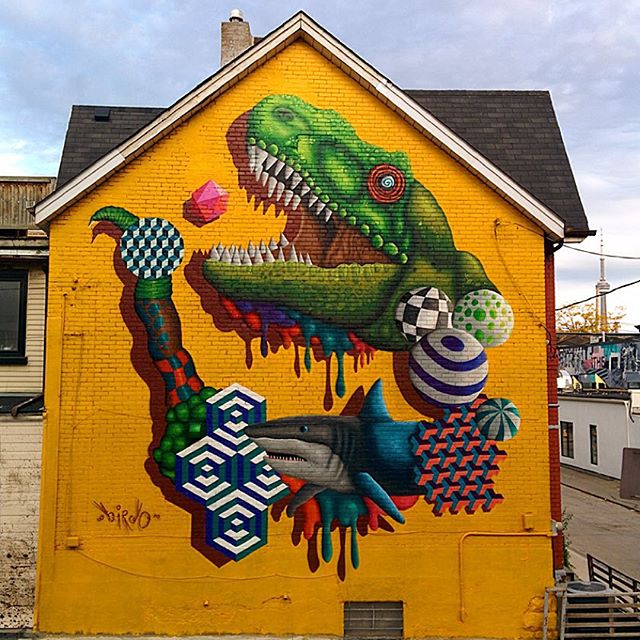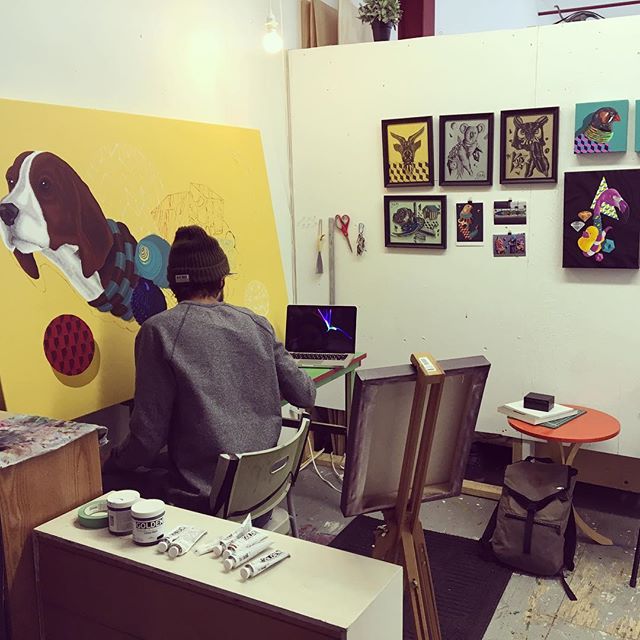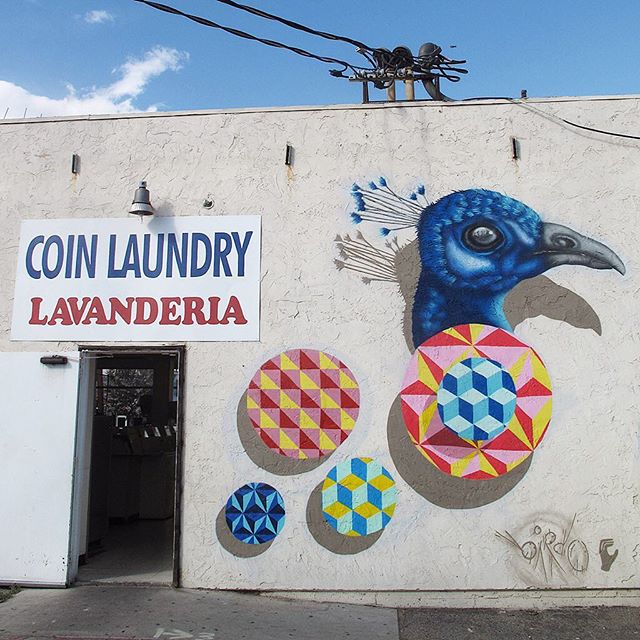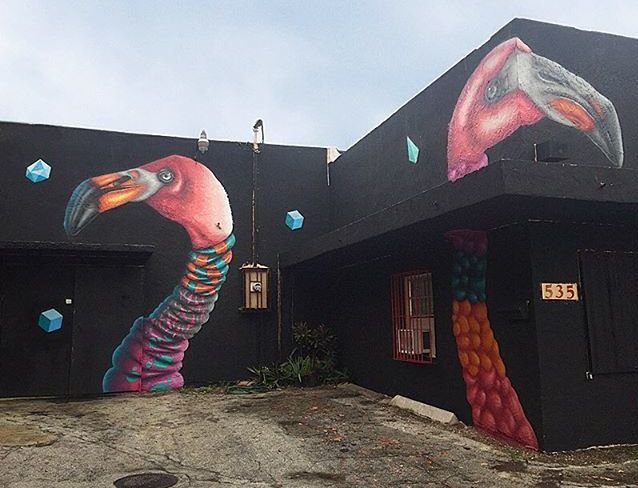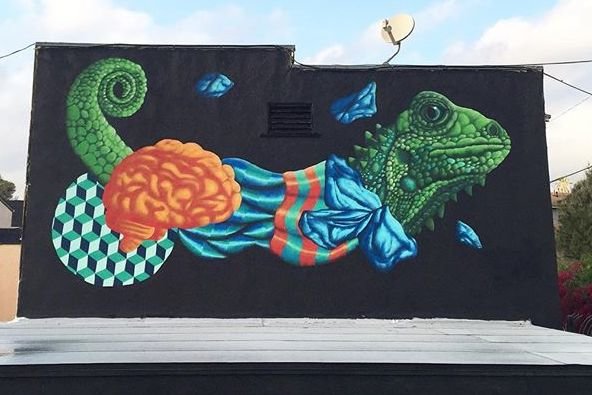Last summer, I ducked into an alleyway behind a shoe store on Queen and Euclid. I did it to see if my curiosity could lead me to find any new artwork. It did. I saw a distinct piece of street art by someone who I had yet to recognize; it was an angular, grey-scale raccoon imposed onto a geometric back-splash.
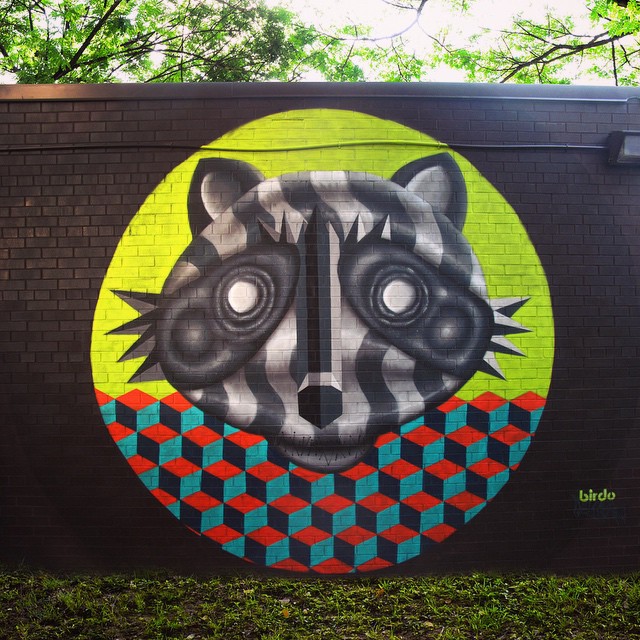 BirdO, Raccoon, Queen and Euclid, Toronto
BirdO, Raccoon, Queen and Euclid, Toronto
If you know what to look for (as I did since that moment), you’ll see that BirdO’s art has since taken over Toronto. He paints large-scale animal hybrid murals that splash onto concrete and brick throughout back alley pockets. The work is sharp, making use of angles and drop shadows to illustrate the absurdity of impossible creatures scattered throughout a grey metropolis. I find the work to be recognizable without being repetitive, and I like the irony that these murals seem to be hidden in plain sight, despite their scale and vividity.
Though BirdO remains anonymous, he’s been involved in some pretty big projects like painting pillar’s at Toronto’s Underpass Park, creating indoor murals for the Drake Hotel, and has been a featured artist in Miami’s Art Basel Festival. In fact, this Toronto bird is quite migratory. BirdO has been making a presence internationally, painting walls in Detroit, Nicaragua, Los Angeles, Miami, Baltimore, and Mexico City. Last weekend, I was invited into his studio, not knowing what to expect from this Canadian muralist who seems to have outgrow his hometown roots.
Because of his anonymity, I had been guessing about the kind of person he would be. I suppose that I was expecting to meet an artist whose personality was as loud as his work, since that’s all I had to go by. BirdO surprised me. He met me with a collected calmness, and welcomed me into his studio space.
I interviewed him as he painted. Starting with the first, almost obvious question, I asked how did he get to where he is now.
BirdO answered, “I’m from Saskatchewan. When I was younger, there were a couple of cats in Saskatoon that were spraying freight trains…That’s how I first got involved. It’s funny because graffiti itself is definitely linked to hip-hop culture. So If you’re kind of into hip-hop and you dig a little deeper, you ask yourself “what’s this graffiti stuff?”. I started coming out to the freight train yard all the time. I fell in love. I was just bumming around – watching people paint, watching the trains go by… that was the first moment I realized that Oh! This is a thing…”.
He spoke slowly as he mixed a shade of turquoise for a commissioned painting he was working on. Unlike many of the people I meet on a day-to-day base, BirdO wasn’t in a rush. He just seemed like he was exactly where he wanted to be in that moment, making careful paint strokes as the conversation went on and he added, “Subsequently, I moved to Toronto and there was graffiti everywhere. The timing was right. I wanted to play.”
I wanted to know about his evolution as an artist, what his style was like when he started, and his thoughts on Toronto versus the international street art scene. He laughingly described how he moved here in 2001 and “spray painted his nickname all over people’s property”.
The question of street art versus graffiti seemed to inevitably come up. It’s a topic that’s over-done, as every “street artist” I’ve spoken to outlines the tensions between the two universes that comes from their opposing philosophies. In short, the graffiti scene is an anonymous counterculture. One that lacks regulation, or hierarchy, and prides itself on a public ownership of space and a lack of rules. Basically: put your tag in the most impressive space, and don’t worry about anyone else. Street art, on the other hand, encourages notoriety of spray paint artists, whose works are often commissioned, and who see hierarchy in aerosol projects. Meaning that a street art mural deserves more respect than a tag. Graffiti and street artists often play a power dance with one another of tagging and repainting murals.
As BirdO explained, “There are two games really. There is graffiti and there is muralism (or as people like to say, street art), and there is definitely friction; the two mediums competing for the same wall space. I’m still trying to find out what my title is. I just paint.” It’s obvious that BirdO still straddles both worlds. DMC is a graffiti crew that he painted with in Toronto as he first started, and his anonymity is a nod to his graffiti roots. But he tells me he finds himself moving farther away from graffiti, “I’ve been really focused on bettering my craft, being called out to international art festivals, painting on short timelines, and taking on residencies”.
He also commented on the difference between the public art scene in Toronto and in other places he’s worked. “It’s Toronto, that’s supposed to be the most progressive city in our country, we’re supposed to be thought leaders, and while we’ve got some agencies trying to be on the forefront of modern thinking in regards to painting with aerosol, we are actually so far behind what other cities are doing”.
BirdO was referencing street art festivals, like Montreal’s Festival Mural, Miami’s Art Basel, Rochester’s Wall Therapy among others. Since the hey-days of Rob Ford’s war on graffiti, Toronto has in fact made strides towards increasing its status as a city that supports public art by funding non-profit public art initiatives like Mural Routes, StreetArtToronto, The PATCH Project, and The STEPs Initiative, but it’s clear that we’ve still got a long way to go.
“Toronto has recently eclipsed Chicago… so when you say that there’s only LA and New York that are bigger cities than us in North America, you really can’t put Toronto on the same scale culturally. And when you travel to the states, they don’t either. That’s a main part of the Toronto dilemma, to get recognized internationally.” We reflected on the fact that much of the international street art scene has been shaped by revolutions, disasters, and conflicts such as the graffiti that existed in Berlin during the 1980’s, murals in Havana that reflect on the country’s communism, or murals of Northern Ireland that express political tensions. Toronto has been lucky in lacking any political issues, huge events or disasters that unite us as people in such a way.
BirdO also tells me that this city has been good to him and he loves it dearly. It is here where he can focus on trying to get better, and Toronto has given him the platform to play and explore, and gives him the confidence and comfort to go out internationally.
From my chat with BirdO and the reflections that followed, I came to see him as an artist that uses Toronto as a stepping stone for grander projects. This isn’t a poor reflection on him, as much as it is a reflection on the potential of our city. There is a paradox between Toronto’s growing presence as an internationally renowned city and how far it still has to go with its cultural programming. BirdO has simply been swept up in this paradox. I hope that he continues to produce amazing artwork for our city as his recognition grows.
Ella Gorevalov

